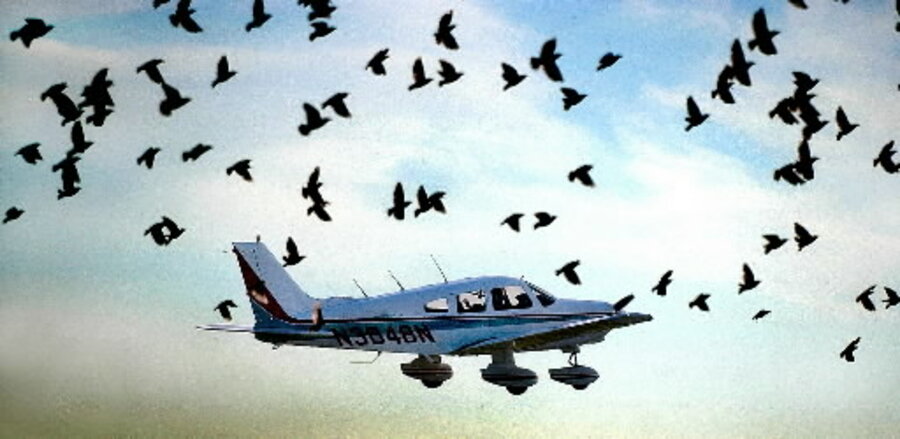After US Airways 'miracle on the Hudson,' concern grows about bird strikes
Loading...
It’s been just a year since US Airways Flight 1549 inadvertently rendezvoused with a flock of Canada geese, sending the Airbus A320 splashing into what everyone now calls the “miracle on the Hudson.” (And the geese into the great beyond.)
Hero-captain Chesley Sullenberger, his flight crew, and some of the passengers got together in New York Friday for a joyous and emotional reunion. Some were more than a little nervous as they rode a ferry out to that spot on the Hudson where their aircraft suddenly became a sinking vessel.
Making aviation officials nervous are the increasing incidents in which birds and aircraft try to occupy the same place at the same time.
"Birds and planes are fighting for airspace, and it's getting increasingly crowded," Richard Dolbeer, an expert on bird-plane collisions who is advising the Federal Aviation Administration and the Agriculture Department, told the Associated Press. For the first time since records have been kept, the number of instances in which aircraft hit birds or other wildlife could top 10,000 for 2009.
Serious damage and loss of life
According to an AP analysis of the latest government figures, there were at least 57 cases in the first seven months of 2009 that caused serious damage and three in which planes and a corporate helicopter were destroyed by birds. At least eight people died, and six more were hurt.
Reported incidents include deer and coyotes on runways, but 98 percent involve birds.
(Personal note: As a student naval aviator on a solo flight in a jet trainer in Mississippi, I narrowly missed a deer that had jumped the fence and wandered onto the runway as I accelerated for takeoff. It came close to being a very bad day for both of us. Years later, when I was on the Monitor’s “Small Plane, Big Planet” aerial adventure, we had to abort the landing of our small Cessna when a herd of zebra ambled across a dirt runway in Namibia.)
Particularly since US Airways Flight 1549’s water landing last January focused attention on the problem, pilots and air traffic controllers have been more inclined to report incidents involving birds and other wildlife.
New York’s Kennedy Airport reports the most number of bird strikes. Sacramento International Airport in California (which is along the Pacific Flyway for migratory birds) also has a high number of reported bird strikes.
Wildlife populations growing
But officials also report steady increases in wildlife populations. In a report for 1990-2008, the Federal Aviation Administration and the US Department of Agriculture write:
“Many populations of wildlife species commonly involved in strikes have increased markedly in the last few decades and adapted to living in urban environments, including airports. For example, from 1980 to 2007, the resident (non-migratory) Canada goose population in the USA and Canada increased at a mean rate of 7.3 percent per year. Other species showing significant mean annual rates of increase included bald eagles (4.6 percent), wild turkeys (12.1 percent), turkey vultures (2.2 percent), American white pelicans (2.9 percent), double-crested cormorants (4.0 percent), and sandhill cranes (5.0 percent). Thirteen of the 14 bird species in North America with mean body masses greater than 8 lbs have shown significant population increases over the past three decades. The white-tailed deer population increased from a low of about 350,000 in 1900 to over 30 million in the past decade.”
If a 12-pound goose strikes an airliner going 150 miles per hour at lift-off, the force would be that of a 1,000-pound weight dropped from a height of 10 feet, according to the FAA.
But it doesn’t take a fat goose to do major damage.
'Feathered bullets'
The Bird Strike Committee calls starlings “feathered bullets.” Starlings, which reach a late-summer population of 150 million-plus, are the second-most abundant bird in North America.
Airports have been installing high-tech gear to discourage birds from hanging around runways, but at least one airport is trying something else.
The Southwest Oregon Regional Airport in North Bend, Ore., hired Filly – a border collie whose official title is “wildlife management canine.”
“She’s chased flocks of geese into the water,” said Bob Hood, the airport’s wildlife manager. “She’s really good at her job and she really likes her job.”
-----
Follow us on Twitter.





